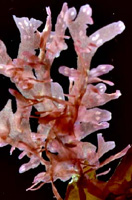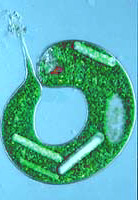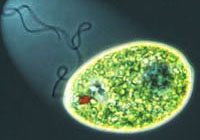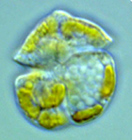The algae are a polyphyletic and paraphyletic group of organisms. They are defined in differing ways, but are usually considered to be the photosynthetic organisms excepting plants. Using the term 'plants' in its most restrictive fashion, the algae are then photosynthetic organisms excepting the sister group to the Charales (i.e. the land plants). Such a definition allows inclusion of photosynthetic prokaryotes such as the cyanobacteria. The definition applied here is that the algae is that artificial subset of the photosynthetic eukaryotes which excludes the sister group to the Charales (land plants).
Left: Dicroglossum crispatulum, a multicellular red
alga (Rhodophyta).
Copyright © 2000 Alan Millar, Royal Botanic Gardens, Sydney, Australia
Right: Euglena oxyuris (Euglenida), a unicellular
alga.
Copyright © 2000 David J. Patterson
The algae are the dominating primary producers in aquatic ecosystems, on unstable substrates (muds and sands) and in intertidal marine habitats. Algae are commonly exploited as foodstuffs, food additives, toothpastes, etc.
The ability for eukaryotes to carry out photosynthesis was made possible by one or more symbiotic associations between heterotrophic eukaryotes and photosynthetic prokaryotes (or their descendents). There were several primary symbioses between eukaryotes and blue green algae. In one lineage, the photosynthetic organism lost much of its genetic independence and became functionally and genetically integrated as chloroplasts within the host cell. Modern chloroplasts, also called plastids, are bounded by two or more membranes, and most usually lie free in the cytoplasm, but in some cases they may be located within a fold of the nuclear envelope, or may be associated with the cytoplasm and residual nucleus of a eukaryotic endosybiont. The descendents of some of these primary plastids have gone on to form further associations. At least two types of protists (chloroarachniophytes and cryptomonads) have acquired 'plastids' by forming symbioses with eukaryotic algae. This are referred to as secondary symbioses.
Algae are distinguished on a number of different characteristics. The most important ones are:
- the colour of the plastids (more correctly the combination of photosynthetic pigments that are present in the plastid)
- the presence of flagella (and if so how many, how do they insert in the cell and how do they beat)
- is the cell surrounded by extracellular material? If so, what is that material - organic or inorganic, a continuous wall or a layer of scales)
- are the cells motile or not?
- do they occur singly, in colonies, filaments or exhibit differentiation that would allow them to satisfy the criterion of multicellularity?
Left: a species of Euglena (Euglenozoa, Euglenida)
with its colour arising from chlorophyll b in the plastids.
Right: Gymnodinium (alveolate, dinoflagellate) with
plastids containing chlorophylls a and c and consequently brown in
colour.
Photographs copyright © 2000 David J. Patterson
Algal protists occur in 8 lineages. These are summarised below.
Groups of Algae
| GROUP | COMPOSITION | ORGANIZATION | MAJOR PIGMENTS |
|---|---|---|---|
| ALVEOLATES | Contains some algae, autotrophic dinoflagellates, diverse, Peridinium, Symbiodinium, Ceratium | unicellular, colonial, syncytial; free-living, symbiotic and parasitic | chlorophylls a and c, some symbionts |
| CHLORARACHNIOPHYTES | A few genera of amoeboid organisms all with symbiotic algae, Chlorarachnion | syncytial, free-living | Chlorophyll b |
| CRYPTOMONADS | About 12 genera of flagellates, Cryptomonas | single cells, rarely forming colonies, some are endobiotic | Chlorophylls a and c, phycobilins |
| EUGLENIDS | about half of the genera (35) contain members with green chloroplasts, flagellates, Euglena, Trachelomonas | single cells | Chlorophyll b |
| GLAUCOPHYTES | Several genera of flagellated and non-flagellated protists with similar phycobilin-rich symbionts, e.g. Glaucocystis, Cyanophora | flagellated and non-flagellated cells | Phycobilin |
| HAPTOPHYTES | Diverse, with many genera, all or all bar one genera with plastids, with naked species and those with scales (coccolithophores) | single cells, some are endosymbionts | Chlorophylls a and c |
| RED ALGAE (Rhodophyta) | All species are regarded as algal | free-living and parasitic, single celled, and multicellular | Phycobilins |
| STRAMENOPILES | Most but not all stramenopiles are algae, the group includes diatoms, brown algae, synurophytes and other 'chrysophytes' | single celled, colonial and multicellular, free-living and parasitic | Chlorophylls a and c |
| VIRIDAEPLANTAE | The green algae, all but a few genera are algal, prasinophytes, chlorophyta (e.g. volvocalean algae, conjugatopohytes, Ulvales, Charales) | single celled, colonial and multicellular, free-living | Chlorophyll b |
Genera of algal protists for which no clear ultrastructural identity has been developed (after Patterson, 1999):
|
|
|
|









 Go to quick links
Go to quick search
Go to navigation for this section of the ToL site
Go to detailed links for the ToL site
Go to quick links
Go to quick search
Go to navigation for this section of the ToL site
Go to detailed links for the ToL site